

The data and information on this page come from the January 1996 issue of Boating Industry. It has a special report containing much more information than is reproduced here. We are presenting portions of it as an example of the types of data in their more current reports and to provide a "feel" for the size of the industry. Their current reports contain much more information. Some of data is from the NMMA (National Marine Manufacturers Association).
For more current information consult:

Introduction
The NMMA estimates retail pleasure boating expenditures increased by 22.4% in 1995, reaching $17,226,203,000. Looking at historical data and inflation, the organization recognizes that boating is loosing market share to other discretionary expenditures. They cite new boat expenditures declining from 6% of disposable income in 1980 to 4% of disposable income in 1993.
To encourage growth they are encouraging expansion beyond the traditional white middle aged male market. PWC sales were up 40% in 1995 to 200,000 units. This is an example of expanding the traditional market.
The price of outboards was influenced by the increase in the costs for aluminum. Unit sales were up 5% but average cost was up 21% to $6,175. This is the first year the NMMA has reported jet boat sales. The 14,839 units had an average cost of $9,646 and were seen as a "step up" purchase for PWC riders.
The total ownership of boats is reported graphically below. The difference between power units and boats is attributable to the use of twins or triples on some boats.
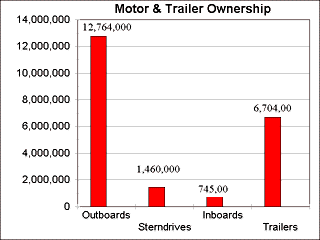
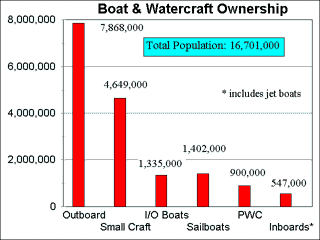
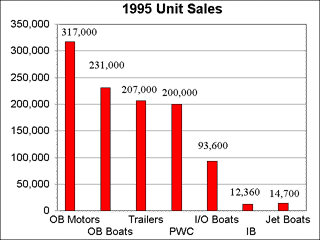
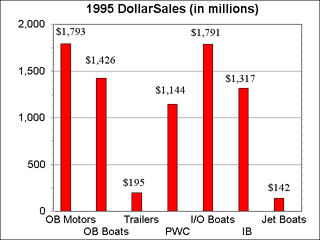
OB motor sales increased 2.9% in 1995 to 317,000 units.

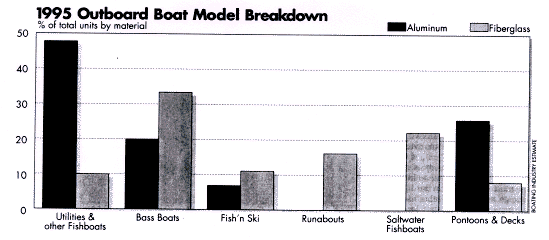
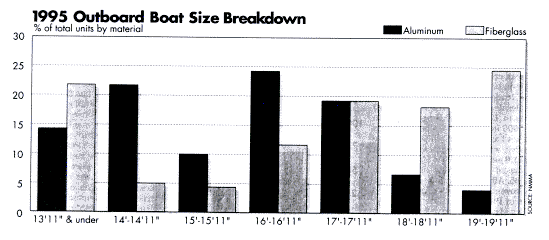
Stern drive boat sales increased 4% in 1995 to 93,600. Average boat costs were up 3.2% to $19,138. The 3 most popular sizes were reported to be 18-footers, 20-footers, and 22- to 23-footers with roughly 26, 23,an 15 % of the market respectively. Bowriders claimed 75% of all stern drive sales. Cruisers claim the bulk of the remaining units with boats over 28 feet getting twin installations.
Inboard Cruiser sales increased 30% to 5,460 with cost only increasing 1% to $214.195. Twin engines are found in more than 95% of these boats. Gas engines are favored under 40 feet and diesel engines dominate the over 40 foot market.
Inboard Runabout sales decreased 4.1% to 6,900 units while their average cost increased 7.9 % to $21,400. Over 90% of these boats are tournament ski boats.
!4,700 units were shipped by wholesalers. Motorsport dealers and boat dealers are both handling the units.
U.S. exports of American made recreational boats decreased 2.3% in 1994 to $507.2 million. Canada is our largest customer and also had a 15.5% increase in 1994 to $134.7 million.
Boat imports increased 32.8% in 1994 to $564,346,000. Canadian manufacturers sent almost half of that ($274.2 million) to the U.S. being helped by the weaker Canadian dollar. Even with higher yen values Japanese imports increased 94.3% to $106.3 million strongly due to PWC's.
There are roughly 10,000 Marine Retailers. They are broken into categories in the graphic below.
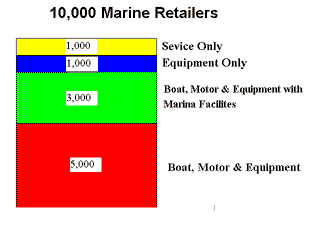
There are also roughly 10,000 marinas and boat yards. They are broken into categories in the graphic below.
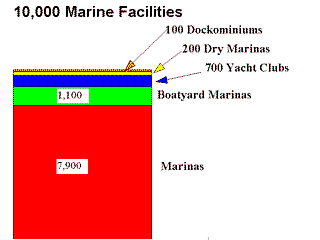

Return to Recreational Boat Building Industry Home Page